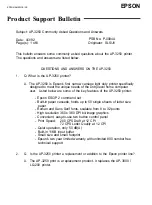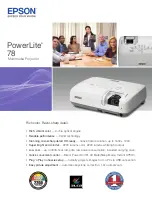
Chapter 2
2-36
1. Sets the FIXING HEATER DRIVE (FSRD) signal "L" through the ASIC and shuts off the heater.
2. Sets the RELAY DRIVE (RLD) signal "L" through the ASIC.
3. Sets the RELAY DRIVE (RLD-) signal "L" through the fixing heater safety circuit.
4. Turns off the relay (RL301) through the relay drive circuit and shuts off the heater.
2) Protective function by the fixing heater safety circuit
This circuit monitors the output voltages (FSRTH1, FSRTH2) of the main/sub thermistors.
When the FSRTH1 is approx. 0.5 V or less (equivalent to 280 deg C or higher), or the FSRTH2 is approx 3.0 V or higher (equivalent to 315 deg C or higher), the
relay (RL301) is turned off and the heater is shut off.
3) Protective function by the thermoswitch
The thermoswitch (TP) gets disconnected to interrupt the current to the fixing heater when it
reads the temperature of over 250 deg C (Note) due to an abnormal temperature rise of the fixing
heater.
The thermoswitch is placed away from the fixing heater. The actual temperature of the fixing heater is higher than the thermoswitch reading.
2.5.3.3 Fixing Unit Failure Detection
0011-6413
The CPU determines fixing unit failures under the following conditions 1) - 3), turns off the relay (RL301), shuts off the heater, simultaneously notifies the failure
to the SCNT board:
1) Abnormal high temperature
* Abnormal high temperature on the main thermistor
If the main thermistor continuously reads 245 deg C or higher for minimum 1 second, the CPU judges
it abnormally high.
* Abnormal high temperature on the sub thermistor
If the sub thermistor continuously reads 290 deg C or higher for minimum 1.5 seconds, the CPU judges it abnormally high.
2) Abnormal low temperature
* Low temperature during temperature control
If the main thermistor continuously detects below 100 deg C for minimum 1 second during the print
temperature control and between-sheets temperature control, the CPU judges it abnormal.
* Abnormal low temperature on the sub thermistor
If the sub thermistor continuously reads below 75 deg C for minimum 2 seconds after 20 seconds from when the heater is energized, the CPU judges it abnormal.
* Break during start-up in the sub thermistor
If the sub thermistor continuously reads below 40 deg C for minimum 1 second after the heater is
energized, the CPU judges that the sub thermistor has a break.
* Break in the main thermistor
If the main thermistor continuously reads below 40 deg C for minimum 0.5 second after the start-up
temperature control, the CPU judges that the main thermistor has a break.
* Break in the sub thermistor
If the sub thermistor continuously reads below 40 deg C for minimum 0.5 second after the start-up
temperature control, the CPU judges that the sub thermistor has a break.
3) Start-up abnormality
* Start-up abnormality 1
If the main thermistor continuously reads below 120 deg C for minimum 1 second after 20 seconds
from when the heater is energized, the CPU judges it abnormal.
* Start-up abnormality 2
If the main thermistor reading never exceeds 5 deg C below the target temperature of temperature
control within 75 seconds from when the heater is energized, the CPU judges it abnormal.
2.6 Engine Control System
2.6.1 Construction
2.6.1.1 Overview
0008-1724
The printer control system controls the laser exposure system, image formation system, pickup/feed system, delivery system, fixing system, and control system.
The printer control system consists of 2 boards: DCNT board and SCNT board.
The following is a block diagram of the printer control system; a brief description of individual circuits follow:
F-2-51
Printer control system
DCNT
board
SCNT
board
Laser exposure system
Image formation system
Pickup/feed, delivery system
Fixing system
Externals and controls system
Print Control System Block Diagram
Summary of Contents for LaserBase MF8180C
Page 1: ...Jan 20 2006 Service Manual MF8100 Series LaserBase MF8180C ...
Page 2: ......
Page 6: ......
Page 20: ...Contents ...
Page 21: ...Chapter 1 PRODUCT DESCRIPTION ...
Page 22: ......
Page 24: ......
Page 32: ......
Page 33: ...Chapter 2 TECHNICAL REFERENCE ...
Page 34: ......
Page 79: ...Chapter 3 DISASSEMBLY AND ASSEMBLY ...
Page 80: ......
Page 90: ......
Page 260: ......
Page 261: ...Chapter 4 MAINTENANCE AND INSPECTION ...
Page 262: ......
Page 264: ......
Page 268: ......
Page 269: ...Chapter 5 TROUBLESHOOTING ...
Page 270: ......
Page 272: ......
Page 286: ......
Page 287: ...Chapter 6 APPENDIX ...
Page 288: ......
Page 290: ......
Page 294: ......
Page 295: ...Jan 20 2006 ...
Page 296: ......
















































